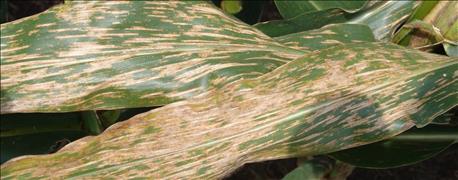
The 2015 growing season has been one of extremes. After one of the wettest springs on record for some parts of Nebraska, temperatures fluctuated from daytime highs of the upper 70s to the upper 90s through July and August. Among other challenges, these extremes brought disease pressure, and different conditions were conducive to different diseases, but the common factor this year was moisture.

DISEASE PRESSURE: Gray leaf spot (pictured) was one of several diseases to rear its ugly head in Nebraska this year. It started with northern corn leaf blight, which showed up in east central Nebraska in June. However, with the increase in temperature, gray leaf spot started showing up, and was the most widespread corn disease in Nebraska this year.
Northern corn leaf blight started showing up in east central Nebraska in June, but with the increase in temperature, gray leaf spot, another fungal disease, also reared its ugly head. "As temperatures began to warm up, and we continued to get rain, conditions became less favorable for northern corn leaf blight and increasingly favorable for gray leaf spot," explains Tamra Jackson-Ziems, University of Nebraska Extension plant pathologist.
With the rise in temperatures, southern rust made its way north from southern states, where it developed earlier this year, and was confirmed in Nebraska in late July, and was soon confirmed in scattered locations across eastern Nebraska. Fortunately, not long after that, temperatures began cooling off again, and became less favorable for southern rust.
Gray leaf spot has been the most widespread. While gray leaf spot and northern corn leaf blight can be managed through crop rotation and tillage (both diseases overwinter on crop residue) resistant hybrids, and timely fungicide applications, some growers who applied a fungicide before tasseling still had problems with gray leaf spot several weeks later.
This left many growers wondering: how late can I apply fungicide and still see results and get a return on investment? Can I apply at early dent, or is it best not to apply fungicide after dough?
~~~PAGE_BREAK_HERE~~~
The answer is complex, considering the cost of fungicide applications and that research shows the most consistent return on investment comes when applications are made at tassel or shortly after when disease is present. "The dilemma is some fungicides may only last for a few weeks and the disease might outrun it," says Jackson-Ziems. "If your fungicide only lasts three or four weeks, but you have the 10 or 12 weeks to fill grain, you have plants that may become vulnerable again later on once protection provided by some products wears off."
Research at the South Central Ag Laboratory near Clay Center in 2008 shows late fungicide applications for gray leaf spot can pay off. "Those data show that we were able to sometimes see a return over the non-treated control, sometimes as late an application made at early dent," says Jackson-Ziems. The yield response to treatments was more consistent in hybrids that were more sensitive to gray leaf spot and had more leaf area affected, although the yield response wasn't always high enough to pay for the application if the corn price is low."
UNL cropping systems agronomist Roger Elmore's data published in the Iowa State University Corn Growth and Development manual shows on average, there can be as much as 55% dry matter accumulation left at early dent. "If you see late season diseases come in, you could still see a lot of damage," Elmore says. "At early R5 (dent), you might be able to justify a fungicide application."
Jackson-Ziems notes some 110 to 115-day hybrids might still have four to five weeks of dry matter accumulation left before black layer at early dent. "That's why I feel some applications made at early dent might still pay for themselves – if it's a susceptible hybrid and disease severity was increasing rapidly," she says. "We're conducting additional research this year on late season applications."
Watch for more information in the October Nebraska Farmer.
About the Author(s)
You May Also Like






